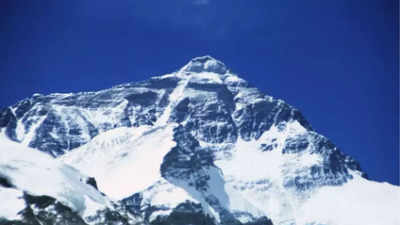- News
- Science News
- Scientists discover two mountains taller than Everest hidden deep within Earth
Scientists discover two mountains taller than Everest hidden deep within Earth
Scientists have discovered massive structures deep inside Earth, beneath Africa and the Pacific Ocean. These structures are continent-sized regions with temperatures much higher than their surroundings. Dating back at least half a billion years, they raise questions about Earth's geological history and dynamic evolution. The research provides new insights into Earth's interior and its seismic behavior.
Scientists have discovered two enormous structures deep inside Earth whose sizes are forcing scientists to rethink the way they see the inside of their planet, at the boundary between Earth's core and the mantle, beneath Africa and the Pacific Ocean, these "islands" described as continent-sized regions whose temperatures are thousands of degrees higher than the average temperature of the surroundings. According to new research from Utrecht University, these structures are not only gigantic but also old, with origins at least half a billion years ago. The discovery raises new questions about the geological history of the planet and the forces shaping its interior, offering fresh insights into Earth's dynamic evolution.
Earth's biggest hidden mountains revealed deep beneath Africa and the Pacific Ocean
The world's largest mountains have been found deep inside Earth, according to a landmark paper published in the journal Nature today. These giants are some 100 times higher than Mount Everest, rising 1,000 kilometers, while Everest's peak is about 8.8 kilometers above the sea. Researchers estimate that these mountains are at least half a billion years old, dating back to the Earth's formation, over four billion years ago.
Scientists say the mountains are at least 500 million years old and probably date back to Earth's origin. Surrounding the mountains is tectonic debris that comes from subduction, in which one tectonic plate is sunk beneath another. Seismic shockwaves have led scientists to reveal these giant land masses hidden in Earth's core and map its interior. The lead researcher, Dr. Arwen Deuss, does not know the origin of these mountains; it is a matter of whether they are transient structures or an old age mountain. This new discovery shook the understanding that existed within geology and further revealed the dynamics into the history of the Earth's interior.
Scientists find mysterious "islands" beneath Earth with unpredictable seismic behavior
LLSVPs Large Low Seismic Velocity Provinces Large blobs of unknown, mysterious material lurking deep beneath our Earth's surface lie at the core-mantle boundary beneath Africa and the Pacific Ocean. Enormous "islands," they are found surrounded by a "graveyard" of cold sunken tectonic plates descended through the mantle via subduction. Seismic waves are slowed down as they travel through Earth's interior because of its very high temperatures in these regions.
In a new study, researchers Arwen Deuss and Sujania Talavera-Soza approached things differently. Instead of measuring just the slowdown of seismic waves, they measured the waves' damping, or how much energy the waves lose as they travel. Contrary to their expectations, they found that the LLSVPs caused minimal damping, making seismic waves unusually loud, while the surrounding cold tectonic plate graveyard dampened the waves more, offering new insights into Earth's deep interior.
Unusual seismic behaviour revealed Earth's deepest secrets
The LLSVPs have remained enigmatic with deep, puzzling features located deep in Earth. Located near the boundary between Earth's core and its mantle, LLSVPs are hotter than surrounding tectonic plates. Analyzing seismic waves did something surprising; their energy dissipation or loss due to friction with Earth was lower compared to what has been considered usual, thereby causing the sound emitted to be surprisingly louder than other seismic events.
Differently, the cold tectonic plate graveyard exhibited tremendous damping where the waves could be described to be softer. This was contrary to previous assumptions set forth that the upper mantle would dampen the waves. The scientists believe that the LLSVPs are much older and include bigger grain minerals that take less energy absorbed, meaning that explains their unusual seismic response.
Also Read: UFOs underwater? Congressman Burchett says massive craft spotted beneath the waves
End of Article
FOLLOW US ON SOCIAL MEDIA
Hot Picks
TOP TRENDING
Explore Every Corner
Across The Globe












